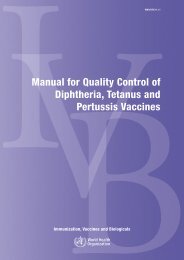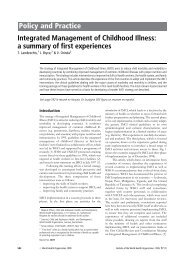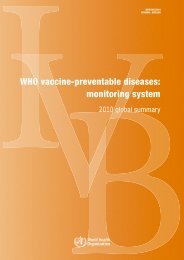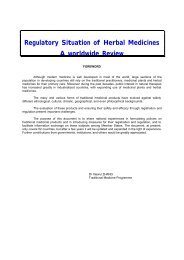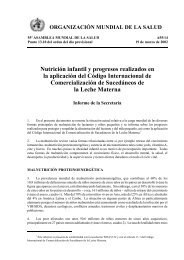IPDE - Extranet Systems - World Health Organization
IPDE - Extranet Systems - World Health Organization
IPDE - Extranet Systems - World Health Organization
Create successful ePaper yourself
Turn your PDF publications into a flip-book with our unique Google optimized e-Paper software.
4 A. A. Dahl and A. Andreoli<br />
Psychoanalysis introduced a general theory of personality develop<br />
ment based on the solution of phase-specific drive conflicts during childhood.<br />
From this emerged the oral, anal, and phallic-genital personality<br />
types. As psychoanalysis progressed from a focus on drive conflicts to<br />
tbe study of ego functions, object relations, and self-development, a<br />
more interpersonal view was taken to describe conflicts and defects in<br />
personality functioning. For example, various interpersonal wishes and<br />
fears characterize the personality types described by Smith Benjamim2<br />
Recently, a basic separation of temperament and character was proposed<br />
by Cloninger et al..' who stated that descriptive data about individual<br />
behaviour were insufficient to permit strong preferences among alternative<br />
ways of summarizing personality traits. They proposed a general<br />
psychobiological model of personality based on three temperamental<br />
and four character dimensions.<br />
Deviant personalities, psychopathies, and personality disorders<br />
The problems in describing normal personality raise the fundamental<br />
question of what the difference is between normal and abnormal personality.<br />
Disorders of personality were described in the nineteenth century,<br />
along with such concepts as character, constitution, temperament, and<br />
self.4 Pinel. in 1801, described personalities that were deviant in their<br />
emotions. Prichard, in 1835, identified patients who violated social nonns<br />
as having 'moral insanity'. He raised the fundamental question, still very<br />
important in forensic psychiatry, of whether deviant personalities are mad<br />
or bad. In 1873, Koch described personality deviance in several domains<br />
as 'psychopathic inferiorities', thereby embracing the view of More1 that<br />
those with deviant personalities are inferior to normal people. The moralistic<br />
attitude towards deviant personalities was based on this assumption,<br />
and a derogatory view of patients with PD is still quite common.<br />
From the very beginning PD was debated as a nosological entity,<br />
because of moral judgements about unacceptable personality traits,<br />
problems of their delimitation with normality, and the lack of guilt and<br />
remorse in many such patients. Because individuals with PD often did<br />
not consider themselves mentally ill, their diagnosis was less reliable<br />
than it was for many other mental disorders.<br />
SchneiderJ proposed the view that personality traits are continuously<br />
distributed, the extreme deviations of a trait being pathological, if the individual<br />
or society suffered because of them. His 10 types of PD illustrate<br />
the fundamental arbihariness of categorical classification of abnormal




